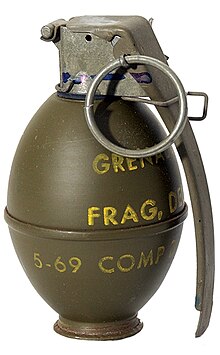| M26 grenade | |
|---|---|
 M61, a variant of the M26 (manufactured in May 1969) | |
| Type | Hand grenade |
| Place of origin | United States |
| Service history | |
| In service | 1950s–present |
| Used by |
|
| Wars | Korean War, Vietnam War, Six-Day War, Yom Kippur War, Falklands War, Syrian Civil War |
| Production history | |
| Produced | 1950s–present |
| Specifications | |
| Mass | 16 oz. [454 g][1][2] |
| Length | 99 mm[1] [3 7/8 inches] |
| Diameter | 57 mm[1] [2 1/4 inches] |
| Filling | Composition B |
| Filling weight | 5.75 oz. [164 g][1] |
Detonation mechanism | M204-series Timed Friction Fuse [3] |
The M26 is a fragmentation hand grenade developed by the United States military. It entered service around 1952 and was used in combat during the Korean War. Its distinct lemon shape led it to being nicknamed the "lemon grenade" (compare the Russian F1 and American Mk 2 "pineapple" grenades).
Fragmentation is enhanced by a special notched fragmentation coil that lies along the inside of the grenade's body.[4] This coil had a circular cross-section in the M26 grenade and an improved square cross-section in the M26A1 and later designs.
The grenades were stored inside two-part cylindrical fiberboard shipping tubes (Container M289) and were packed 25 or 30 to a crate.
- ^ a b c d LEXPEV. "M26, M26A1 & M61". Lexpev.nl. Retrieved 2014-05-03.
- ^ "Hand Grenades". Inetres.com. Retrieved 2014-05-03.
- ^ "Table 1: Authorized Hand Grenades". Archived from the original on 2016-03-04. Retrieved 2013-03-19. Training Manual TM-9-1330-200-12 Grenades. Table 1: Authorized Hand Grenades3
- ^ Copyright 2001-2005 Inert-Ord.net. "U.S. M61 Fragmentation Grenade (Vietnam)". Inert-Ord.net. Retrieved 2014-05-03.
{{cite web}}: CS1 maint: numeric names: authors list (link)